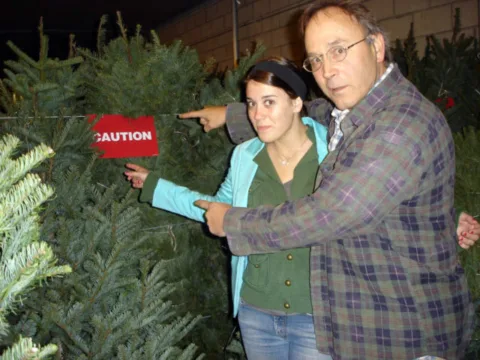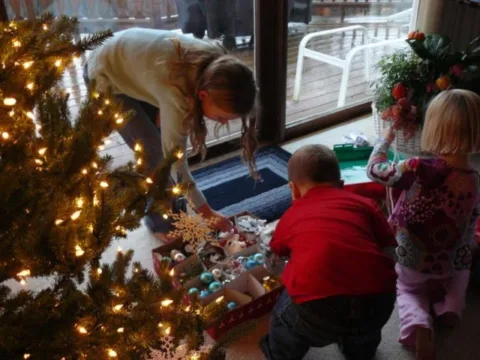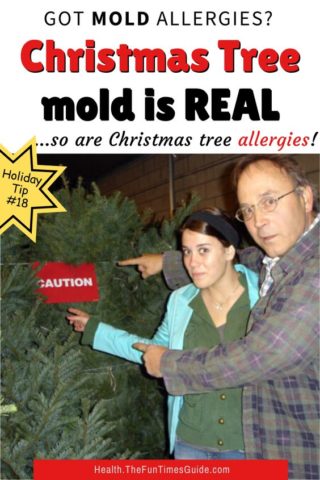Who doesn’t love the scent of freshly-cut balsam for the holidays?
And the look of fresh cedar boughs twisted around the stair railings and evergreen wreaths above the fireplace?
But if you happen to have tree allergies or mold allergies, all of this Christmas loveliness is bad for your health!
Think you just have a cold? You might have Christmas tree allergies.
Most Christmas trees are cut in advance of the holidays and stored in a moist environment, making them a likely mold source. However, artificial trees and ornaments collect dust in storage and are therefore another possible source of allergy irritation. Source
Wonder Why You Always Get The Sniffles During The Holidays?
If you tend to start sneezing and wheezing around Christmastime, you could be allergic to the tree mold.
Mold is a small fungus which forms on animal or vegetable matter. It is often associated with decay.
Studies have shown a marked increase in sinus problems and asthma attacks over the 2 weeks that Christmas trees are common in the home.
The mold count from a live Christmas tree rose to 5 times the normal level 2 weeks after the tree was brought indoors, and that can prove problematic for people with mold allergies. Source
How Do Christmas Trees Affect Our Allergies?
Once a tree is cut down at the Christmas tree farm it begins to die, and the decay begins within a couple of days.
Here’s why Christmas tree mold is an issue:
- Even though it’s not visibly decaying, it is.
- Christmas trees are coniferous softwoods and have a high moisture content.
- Mold loves moisture.
- The tree may take 6 years to grow before it’s cut.
- In that period it can collect all sorts of mold, dust pollens and allergens.
It’s a common growth on outdoor vegetation, but when outdoor vegetation is brought indoors, the normal mold level in a home increases substantially.
Mold. It’s invisible to the naked eye, it floats in the air like pollen, and your exposure to it may increase during the holidays because mold spores love damp evergreens like the wreaths, boughs, and trees we bring inside this time of year. The mold and mildew in decaying leaves only adds to the irritation as we track them inside on shoes and clothes. Source
Here are 4 trees that won’t get mold.
4 Ways To Prevent Christmas Tree Allergies
If you are among the 15% of Americans who have mold allergies, you don’t have to change your Christmas tradition.
Here are a few tips to help you cut the Christmas mold level in your home, without giving up the tree:
- The longer the tree is in your home, the higher the mold level. If those in your household are prone to mold allergy reaction, but don’t want to give up the Christmas tree, put the tree up Christmas Eve and take it down on New Year’s Day. Try to only keep a live tree in your home 4-7 days max.
- Have your real tree, but don’t bring it inside right away. Wash your tree first with the garden hose. Set the nozzle for a hard spray to get into all those little nooks and crannies on the trunk. Then wipe the trunk thoroughly with a solution of warm water and bleach (1 part bleach to 20 parts water). Let it dry in the sun before bringing it in your house.
- Run an air purifier in the same room as the live tree. Cleaner air is key during the holidays and in order to reduce your mold exposure and lessen the effects of your tree allergies.
- The best way to avoid the mold infestation is to buy an artificial tree
. Unless you store it in a sealed plastic bag, it will still need a good shaking outside when it’s brought out of storage each year to relieve it of dust. Also, store all of your Christmas ornaments and decorations in plastic containers (instead of cardboard ones) to keep the dust off them.
For the record, recent tests indicate that girdling trees as they grow will reduce susceptibility to mold fungi, but it could be some time before Christmas tree farms take to girdling all their trees or even consider it.
It would increase costs for the farmer, and those costs would then be passed on to the consumer.
More About Christmas Mold & Tree Allergies
- Holiday Allergies 101
- What You Can Do About Christmas Tree vs. Allergies
- 11 Common Holiday Hazards And How To Avoid Them
- Is Your Christmas Tree Ruining Your Holiday?
- Green Conscious Alternatives to Live Christmas Trees
Like this post? Save it to read again later… or share with others on Pinterest!







